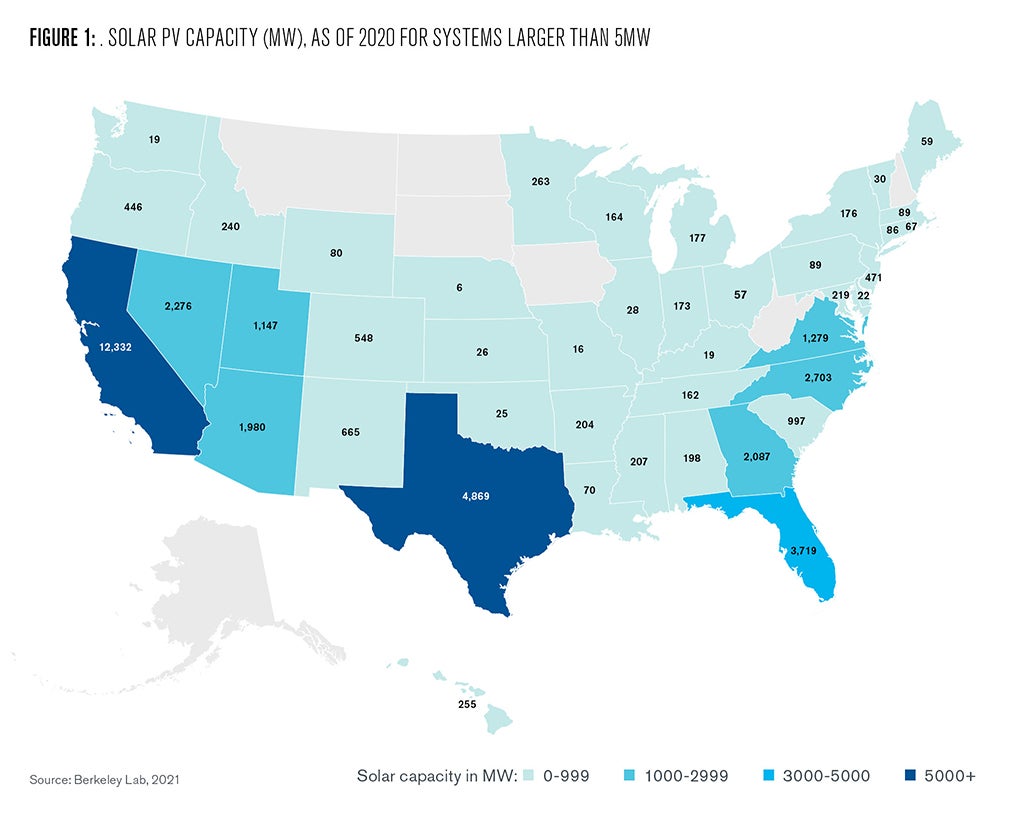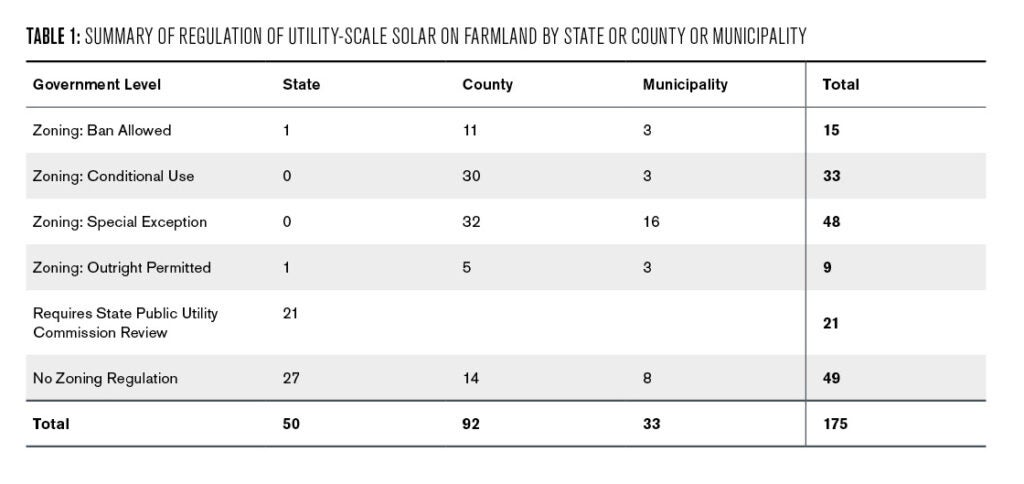Regulating Utility-Scale Solar Projects on Agricultural Land

Farmland is attractive for utility-scale solar because of the large land parcels needed. This study reviewed how zoning has been used to approve or deny solar projects on farmland.
At a Glance
Key Challenge
The development of utility-scale solar on farmland must be done carefully to maintain food production.
Policy Insight
State and local governments need to adopt zoning ordinances that are clear about what is required to build a utility-scale solar system and where the systems can be built.
Introduction
A utility-scale solar project has a capacity of five or more megawatts to generate electricity from sunlight using an array of solar panels. A five-megawatt solar plant takes up at least 25 acres and provides enough electricity to power 500 to 1,200 homes, but many utility-scale solar projects generate more than 100 megawatts.
To reach President Biden’s goal of 100% renewable electricity by 2035, the United States will need to build thousands of utility-scale solar projects covering millions of acres (Krishnamurthy and Serpell 2021). Part of the reason is that solar panels are not energy dense, converting only about 25% of sunlight into electricity. More efficient solar panels would need less space.
Rural areas and agricultural land present attractive sites for utility-scale solar because of the large parcel sizes that limit conflicts with neighboring properties. Some people, however, oppose using agricultural land for solar projects for aesthetic reasons, the potential loss of food and fiber production, or the effects on the local agricultural industry. The competition for land between utility-scale solar and agricultural production will likely increase. But there are ways to accommodate agriculture and solar projects on the same property.
Where utility-scale solar will be built and the size of these projects will depend heavily on local government land use regulations. Key decisions will be: 1) whether to allow utility-scale solar projects; and, if so 2) how to determine the location, construction, operation, and retirement of solar facilities.
Utility-Scale Solar Projects
Utility-scale solar comprises the majority of U.S. solar electricity generation. In 2021, the U.S. had a solar electricity capacity of 113.5 GW, able to power 21.8 million homes. In the first nine months of 2021, solar projects made up 54% of the nation’s new electric generating capacity (SEIA 2021).
One reason for the growth in utility-scale solar is the sharp decline in the cost of solar panels since 2010 (Bolinger et al. 2021). Together, solar and wind facilities now supply almost 11% of U.S. electricity and at a lower cost compared to coal and nuclear power (U.S. EIA 2020).
Yet, solar facilities generate intermittent power because the sun doesn’t shine at night or on cloudy days. The development of large storage batteries is the leading way to overcome the intermittency problem. Although storage battery technology continues to improve, utility-scale solar projects cannot fully replace coal, natural gas, or nuclear power plants.
A utility-scale solar project consists of hundreds to thousands of ground-mounted solar panels and often includes nearby buildings that contain large batteries to store power for future use. A utility-scale solar project may be referred to as a solar farm, solar park, solar plant, or a solar power station. The primary purpose of utility-scale solar is to generate electricity and send it to customers off site. A utility-scale solar plant is either owned by a public utility or a rural electric cooperative.
Three levels of government regulate utility-scale solar. The Federal Energy Regulatory Commission (FERC) must grant approval for the interstate transmission and sale of electricity. A state public utility commission (PUC) sets electricity rates and in some states the PUC must grant approval for a new solar project.
Individual counties and townships can adopt rules for: 1) whether to allow a utility-scale solar facility; and, if allowed, 2) the location, size, and retirement of a utility-scale solar facility (see sidebar). The approval process for a utility-scale solar project typically takes three to five years (SEIA 2022).
There are economies of scale in developing and operating utility-scale solar projects. Generally, a utility-scale project can produce 1 kilowatt (kW) per 100 square feet of solar panels (YSG Solar 2022). Adding in land buffer and buildings, a five-megawatt (MW) facility requires between 5 and 10 acres per megawatt of electricity generated (SEIA, 2022).
The average cost of developing utility-scale solar varies from around $500,000 to $700,000 per megawatt. For example, a five-megawatt solar project will cost about $3 million to build (Solar Reviews 2020). Many utility-scale solar projects exceed 100MW. Developers generally want land located within two miles of an electrical substation and within 1,000 feet of three-phase power (alternating current). Profit for a utility-scale solar project is estimated at about $20,000-$40,000 per acre (YSG Solar 2022).
Goals of the Study
This study sought answers to several questions about utility-scale solar projects:
- What are the pros and cons of utility-scale solar on farmland?
- In which states are utility-scale solar plants being developed?
- In which states and local jurisdictions are utility-scale solar plants being sited on farmland?
- How are state and local governments regulating utility-scale solar on farmland?
Farmland Pros and Cons
Farmland is attractive for utility-scale solar developers because of the large land parcels and generally level terrain. For landowners, utility-scale solar can mean a substantial monthly lease payment from the solar plant developer (see sidebar).
Utility-scale solar plants can cover up to hundreds of acres and can interfere with scenic views. Removing agricultural land from production can hurt local farm economies and leasing land for utility-scale solar can drive up land rents and prices. Some concerns exist about restoring the site of a solar plant to agricultural production. Still, some landowners have continued to graze small livestock such as sheep, create pollinator space, or raise vegetables amid the solar panels. Growing extensive row crops, however, such as corn or wheat, is not possible.
Utility-Scale Solar Steps
- Form a utility. Investors can form a utility, or an existing electric utility can do business with a landowner.
- Sign a lease option. The utility enters a land lease option of two to five years with a landowner.
- Get local approval. Local governments must approve the project for zoning, subdivision, land development, etc.
- Get PUC approval. The public utility commission must also sign off.
- Get federal approval. The regional transmission operator or FERC signs off on transmission connections.
- Sign a lease. The utility and landowner next enter into a long-term lease.
- Build and maintain. Utility-scale solar operates for 25 or more years.
- Maximize use. Space between solar arrays can be used for grazing, pollinators, and some crops.
- Refurbish. Utility-scale solar can either be renewed or removed—returing the land back to agriculture.
Regulating Solar on Farmland
State and local governments vary in how they regulate utility-scale solar on farmland. Rural governments often lack the expertise to draft a comprehensive plan, zoning ordinance, and subdivision and land development regulations that address utility-scale solar. As a result, they may be unprepared when faced with a proposal for a utility-scale solar project on farmland.
Comprehensive Plan
A comprehensive plan is a blueprint for growth and change in a city, county, or township over the next 10 to 20 years. The plan includes general goals and more specific objectives for a variety of subjects affecting the community: population, economic development, natural resources, and energy, among others.
A local government that wants to encourage the development of utility-scale solar facilities should list this as a goal and objective in the plan. The plan should also identify suitable locations for utility-scale solar projects on the future land use map. The future land use map is the basis for the zoning map, which regulates the location of different land uses to promote public health, safety, and welfare.
Zoning
A zoning ordinance consists of a text describing the different zoning districts (residential, commercial, industrial, agricultural, etc.) and a map depicting the location of each zoning district. A zoning ordinance can regulate the siting, development, operation, and de-commissioning of a utility-scale solar facility.
The zoning ordinance should address:
- Districts in which a utility-scale solar plant may be located
- Minimum lot size on which a solar plant may be sited
- Amount of a land parcel that can be covered in solar panels
- Minimum setbacks from property lines and any related buildings
- Maximum height of a solar array and related buildings
The zoning ordinance may treat a utility-scale solar project as:
- By-right use. Outright permitted
- Special exception. Allowed if project meets specific standards spelled out in the zoning ordinance
- Conditional use. Allowed if approved by the local governing body
For example:
Location. Only in M-1 Industrial Zone or also in an Agricultural Zone
Minimum Lot Size. Must be built on a property of at least 100 acres
Lot Coverage. Cannot cover no more than 50% of the property
Setbacks. Must be set back at least 50 feet from a stream, 150 feet from a river, and 300 feet from any property boundary
Height. No more than 15 feet tall
Use Permits. By-right zoning designation not recommended—a special exception or a conditional use is recommended
Subdivision and Land Development Regulations
Subdivision and land development regulations (SALDO) determine the infrastructure and landscaping the developer of a utility-scale solar project must provide, such as roads and power lines, and vegetation. The SALDO can require an environmental impact assessment for the project, and the local government can use the SALDO to require the developer to post a bond for the eventual removal of the solar project. Often, a local government will combine the zoning and SALDO requirements into a separate solar facilities ordinance.
SALDO requirements can include:
Siting. Solar panels must be sited to minimize glare onto neighboring properties and roadways. A viewshed analysis must be conducted to evaluate the impact on neighboring properties and roadways.
Erosion and Sediment Control. The solar facility must comply with standards for land grading, stormwater management, and pollution control during construction and maintenance of the facility.
Fencing. A fence at least six feet high must be placed around the perimeter of the solar facility and be at least 300 feet from any property boundary.
Vegetative Buffer. A vegetative buffer is required around the solar facility to minimize the visual impact on neighboring properties.
Access. The owner/operator of a solar facility must provide and maintain adequate access for emergency vehicles.
De-Commissioning. A de-commissioning plan may be required from the solar project developer before the local government will issue a zoning permit or approve a land development plan. The local government can require the solar developer to post a bond to ensure that there will be adequate funds available to complete the removal of the solar facility should the developer go bankrupt or not perform the de-commissioning.
States with Utility-Scale Solar
Utility-scale solar exists in most states (See Figure 1). California is the leader with over 12,000 MW installed as of 2020. Texas, Florida, North Carolina, Nevada, and Georgia follow, with between 2,000 and 4,900MW of capacity. Recently, the Southeastern region has installed more new utility-scale solar capacity than any other region (U.S. EIA 2020).

Allowing Solar on Farmland
A search of states, counties, and municipalities found that only two states influence local zoning regulations for utility-scale solar on farmland (see Table 1). Ohio authorizes local governments to ban utility-scale solar plants and to designate areas where solar projects are prohibited (Krouse 2021). By contrast, Florida, permits solar plants by right in county agricultural zoning districts (Florida Senate 2021). Twenty-one states require a review of utility-scale solar projects by the State Public Utility Commission or similar body. Twenty-eight states leave the regulation of solar plants to local governments.
Out of 125 local governments identified, 11 counties and three municipalities banned solar plants from farmland (see Table 1). For example, Santa Clara County, California prohibits commercial solar farms on land zoned for large-scale agricultural uses (Sustainable Energy Roadmap Project 2016). Madison County, Virginia, permits utility-scale solar only in industrial zones (Madison County Zoning and Planning 2021). Five counties and three municipalities permit utility-scale solar plants outright.

Most local governments—32 counties and 16 municipalities—use the special exception permit process to ensure that a solar plant meets certain requirements spelled out in the zoning ordinance. For example, Currituck County, North Carolina allows solar energy facilities in the agricultural zoning district via a special use permit. The zoning ordinance includes specific requirements for setbacks (100-300 feet), height limits (not to exceed 20 feet), maximum parcel size (1,500 acres), glare mitigation, and a certified decommissioning plan (Currituck County 2021).
Thirty-three local governments—30 counties and three municipalities—require a conditional use permit, decided upon by the local elected officials, to build and operate a solar plant. For example, Pima County, Arizona may allow solar facilities on agricultural land in rural zones through a conditional use permit (Pima County 2016).
Approvals and Denials on Farmland
Utility-scale solar projects in our search have been approved for construction and operation on farmland in 25 states. But seven states have denied utility-scale solar proposals on farmland. Figure 2 provides a summary of utility-scale solar installations on farmland by size and status.

The fact that one in five utility-scale solar projects in the study have been denied should raise concerns for solar developers. There may be opportunities for compromise that enable local governments to approve solar projects. Co-locating animal grazing, pollinator production, and even growing vegetables within fenced solar projects—so-called agrivoltaics—can work, especially if the solar panels are placed on tall piers. Limiting the size of solar operations and siting and screening requirements may overcome objections to aesthetics.
Conclusions and Recommendations
States and local governments have the authority to decide whether to allow the development of utility-scale solar facilities in general, and specifically on farmland. The extent of utility-scale solar will depend on case-by-case reviews of solar plant proposals, which can be a time-consuming process. In any land development project, opposition from neighbors and local interest groups is always a possibility.
Farmland presents attractive locations for utility-scale solar because of the large amount of open space and generally level landscape. In addition, farmland owners may view leasing land for utility-scale solar as a good opportunity to supplement their income. Leasing land occurs on a case-by-case basis between the landowner and the solar developer. There is no standard lease contract, but a standard contract could help spur solar development.
To achieve the Biden Administration’s goal of 100% renewable electricity by 2035, millions of acres would have to be covered in solar panels. Most of this land would likely be farmland. Removing large amounts of land from crop production could disrupt some local farm economies. But often the opposition to utility scale solar is a matter of aesthetics. Still, if utility-scale solar can be integrated into agricultural operations, then the solar industry could gain greater acceptance.
States in the South and Southwest are best-suited to utility-scale solar projects because of the long hours of sunshine. Also, the South has the largest regional population in the U.S. Siting utility-scale solar close to end users reduces the loss of electricity in transmission.
Model ordinances exist to guide communities in the regulation of utility-scale solar plants (Gomez and Morley 2021). The location, siting, operation, and de-commissioning of solar plants are all important steps. The clearer the review and approval process, the better solar developers can determine where and how to develop their projects.
Tom Daniels
Crossways Professor, City and Regional PlanningTom Daniels is the Crossways Professor of city and regional planning at the Weitzman School. Daniels directs the concentration in Land Use and Environmental Planning.
Hannah Wagner
Resilience Project Manager, City of Boston Environment DepartmentHannah Wagner is the resilience project manager at the City of Boston Environment Department. She is a graduate of the University of Pennsylvania where she earned a master of city planning with an emphasis in land use and environmental planning.
Berkeley Lab. 2021. “Electricity Markets and Policy: Capacity and Generation by State.” Accessed January 22, 2022. https://emp.lbl.gov/capacity-and-generation-state.
Bolinger, M. J. Seel, W. Joachim, C. Warner, and D. Robson. 2021. “Utility-Scale Solar, 2021 Edition.” Lawrence Berkeley National Laboratory. Accessed February 8, 2022. https://emp.lbl.gov/sites/default/files/utility_scale_solar_2021_edition_slides.pdf.
Currituck County, North Carolina. 2021. “Unified Development Ordinance.” Accessed May 15, 2022. https://co.currituck.nc.us/wp-content/uploads/udo-21jun18.pdf.
Florida Senate, 2021. “CS/CS/CB 896: Renewable Energy.” Accessed February 6, 2022. https://www.flsenate.gov/Session/Bill/2021/896.
Gomez, A. and D. Morley. 2021. Solar@Scale: A Local Government Guidebook for Improving Large-Scale Solar Development Outcomes. Washington, DC: International City Manager’s Association and American Planning Association. Accessed February 20, 2022. https://www.planning.org/publications/document/9222548/.
Krishnamurthy, A. and O. Serpell. 2021. Harvesting the Sun: On-Farm Opportunities and Challenges for Solar Development. Kleinman Center for Energy Policy. Accessed January 20, 2022. kleinmanenergy.upenn.edu.
Krouse, P. 2021. “Gov. DeWine Signs Senate Bill 52 Giving Counties Control Over Large Wind and Solar Projects.” Cleveland.com. July 13, 2021. Accessed February 16, 2022. https://www.cleveland.com/news/2021/07/gov-dewine-signs-senate-bill-52-giving-counties-control-over-large-wind-and-solar-projects.html.
Madison County, Virginia Zoning and Planning. 2021. “Zoning and Floodplain Ordinance.” Accessed February 8, 2022. https://www.madisonco.virginia.gov/sites/default/files/fileattachments/zoning_amp_planning/page/4320/madisonzoningordin.pdf.
Pima County, Arizona. 2016. “Commercial Solar Farm Fees and Permitting Guidelines.” Accessed May 16, 2022. https://www.webcms.pima.gov/UserFiles/Servers/Server_6/File/Government/Development%20Services/Building/Solar%20Farm%20Process%20and%20Fees.pdf.
Solar Energy Industries Association (SEIA). 2022. “Siting, Permitting, and Land Use for Utility-Scale Solar.” Accessed February 2, 2022, https://www.seia.org/initiatives/siting-permitting-land-use-utility-scale-solar#:~:text=Depending%20on%20the%20specific%20technology,land%20and%20clearing%20of%20vegetation.
Solar Energy Industries Association (SEIA). 2021. “Solar Market Insight Report 2021 Q4.” Accessed February 1, 2022, www.seia.org.
Solar Reviews. 2020. “What is a Solar Farm? Costs, Land Needs and More.” Accessed February 17, 2022. www.solarreviews.com.
Sustainable Energy Roadmap Project. 2016. Large-Scale Solar and Agricultural Lands: Balancing Clean Energy and Food Production in the San Joaquin Valley. Accessed January 28, 2022. https://www.cleanenergyroadmap.com/wp-content/uploads/2016/01/SolarAgLands-WhitePaper_01-26-2016.pdf.
U.S. Energy Information Administration. 2020. “Total Energy.” Accessed January 20, 2022, https://www.eia.gov/totalenergy/data/browser/index.php?tbl=T07.02A#/?f=A&start=2019&end=2020&charted=8-10-11-12-13-14.
YSG Solar. 2022. “How Much Money Can a Solar Farm Make in 2022?” January 10, 2022. Accessed February 17, 2022. www.ysgsolar.com.


